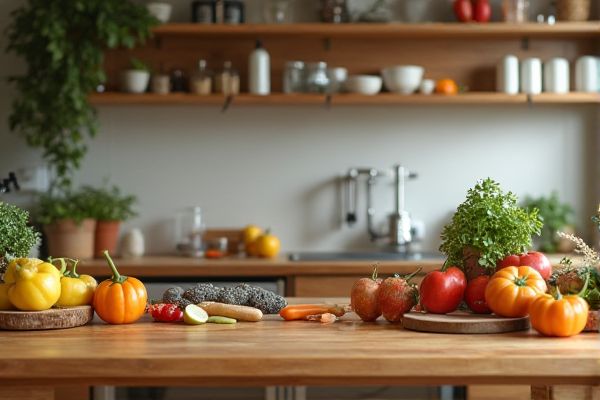
A juicer table is specifically designed with features tailored for efficient juice extraction, including compartments for fruits and easy-to-clean surfaces, while a prep table offers a versatile workspace suitable for various food preparation tasks with ample storage. Understanding the differences between these tables can help you choose the best fit for your kitchen needs; continue reading to explore their unique benefits and applications.
Table of Comparison
| Feature | Juicer Table | Prep Table |
|---|---|---|
| Primary Use | Supports juice extraction with built-in space for juicer machines | Designed for food preparation and ingredient organization |
| Surface Material | Durable, juice-resistant stainless steel or plastic | Stainless steel or cutting board surface for chopping and assembling |
| Storage | Limited storage, mostly for juicer accessories | Multiple shelves or compartments for ingredients and utensils |
| Design | Compact with designated juicing area and waste disposal | Larger work surface with open layout for versatile prep tasks |
| Use Case | Ideal for juice bars and beverage stations | Best suited for kitchens requiring comprehensive food preparation |
| Price Range | Moderate to high, depending on features and materials | Varies widely, typically affordable to mid-range |
Introduction to Juicer Tables and Prep Tables
Juicer tables are specialized workstations designed to support commercial juicing operations, featuring built-in slots for juicers and easy clean-up surfaces to handle fruit pulp and juice spills. Prep tables serve as versatile kitchen work surfaces with refrigerated compartments or storage below, optimized for food preparation, ingredient organization, and maintaining freshness. Both juicer tables and prep tables enhance efficiency and hygiene in foodservice environments by providing dedicated spaces tailored to specific tasks.
Key Differences Between Juicer and Prep Tables
Juicer tables are specialized surfaces designed to securely hold and stabilize juicers, often featuring slots or grooves for pulp collection and easy cleaning, while prep tables serve as versatile workstations for food preparation with flat, spacious surfaces ideal for chopping, slicing, and organizing ingredients. Juicer tables typically include features like built-in pulp bins and spill guards to accommodate juicing tasks, whereas prep tables prioritize durability and ample space to handle various culinary activities beyond juicing. The key difference lies in their design focus: juicer tables enhance efficiency and cleanliness specific to juice extraction, whereas prep tables offer multifunctional support for broader food preparation needs.
Design and Construction Features
Juicer tables feature sturdy, stainless steel surfaces with built-in compartments and drainage systems designed to handle high volumes of fruit efficiently, ensuring hygiene and ease of cleaning. Prep tables prioritize ample workspace combined with temperature-controlled storage underneath, constructed with durable materials such as stainless steel to maintain food safety standards and facilitate organization during food preparation. Both tables incorporate ergonomic designs tailored to streamline workflow, but juicer tables emphasize juice-specific functionality while prep tables focus on versatile meal prep requirements.
Intended Uses in Commercial Kitchens
Juicer tables are designed specifically for extracting juice efficiently in commercial kitchens, featuring built-in juicing machines and easy-to-clean surfaces to handle high-volume beverage preparation. Prep tables serve a broader purpose, providing ample refrigerated storage and workspace for chopping, mixing, and organizing ingredients, making them essential for overall food prep tasks. Your choice depends on whether your kitchen prioritizes juicing operations or versatile food preparation needs.
Benefits of Using a Juicer Table
A juicer table offers a dedicated, ergonomic workspace designed specifically for juicing tasks, enhancing efficiency and workflow in busy kitchens. Its optimized surface and built-in drainage streamline the juicing process, reducing mess and simplifying cleanup. Investing in a juicer table supports better organization and maximizes productivity, helping you to prepare fresh juices quickly and hygienically.
Advantages of a Prep Table
A prep table offers superior organization and efficiency with its spacious work surface and built-in refrigerated storage, ideal for maintaining fresh ingredients during food preparation. Unlike a juicer table, which is specialized for juicing tasks, a prep table supports versatile culinary activities, ensuring better workflow in busy kitchens. Enhanced durability and easy-to-clean stainless steel construction make prep tables essential for maintaining hygiene and optimizing food prep processes.
Space and Layout Considerations
Juicer tables are designed with compact dimensions and built-in drainage systems to efficiently accommodate juicing equipment while optimizing limited kitchen space. Prep tables typically offer larger flat surfaces with integrated storage compartments, facilitating ingredient organization and food preparation workflow. Choosing between the two depends on the specific spatial constraints and operational needs of the kitchen layout.
Hygiene and Cleaning Requirements
Juicer tables feature smooth, non-porous surfaces designed for quick and easy cleaning, minimizing bacterial buildup and ensuring optimal hygiene in food preparation areas. Prep tables often have compartments and drawers that require more detailed cleaning to prevent contamination from food debris and liquids. You can maintain a safer kitchen environment by choosing a table with materials and construction that simplify sanitation and meet health regulations effectively.
Cost Comparison and Value
Juicer tables typically cost less upfront than prep tables, making them a budget-friendly choice for specialized tasks like fruit and vegetable juicing. Prep tables, however, offer greater versatility and durability, often justifying their higher price with multifunctional use in food preparation beyond juicing. Investing in a prep table can provide better long-term value by serving a wider range of kitchen needs and reducing the need for additional equipment.
Choosing the Right Table for Your Needs
Choosing between a juicer table and a prep table depends on your specific kitchen operations and space requirements. A juicer table is designed with built-in juicing equipment and easy-to-clean surfaces, making it ideal for juice bars or cafes with high beverage demand. Your decision should consider workflow efficiency, equipment integration, and the type of food preparation to ensure optimal productivity.
 homyna.com
homyna.com